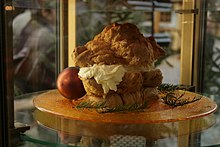Profiterole
 A plate of cream puffs | |
| Alternative names |
|
|---|---|
| Place of origin | Europe |
| Region or state | France and Italy |
| Main ingredients | Choux pastry Filling: whipped cream, custard, or ice cream |
| Other information | Water based, milk based |

A profiterole (French: [pʁɔfitʁɔl]), cream puff (US), or chou à la crème (French: [ʃu a la kʁɛm]) is a filled French choux pastry ball with a typically sweet and moist filling of whipped cream, custard, pastry cream, or ice cream. The puffs may be decorated or left plain or garnished with chocolate sauce, caramel, or a dusting of powdered sugar. Savory profiterole are also made, filled with pureed meats, cheese, and so on. These were formerly common garnishes for soups.[1]
The various names may be associated with particular variants of filling or sauce in different places.[2][3][4][5]
Preparation[]
Choux pastry dough is piped through a pastry bag or dropped with a pair of spoons into small balls and baked to form largely hollow puffs. After cooling, the baked profiteroles are injected with filling using a pastry bag and narrow piping tip, or by slicing off the top, filling them, and reassembling. For sweet profiteroles, additional glazes or decorations may then be added.
Presentation[]


The most common presentations are pastry cream, whipped cream, or ice cream filling, topped with powdered sugar or chocolate ganache and possibly more whipped cream. They are also served plain, with a crisp caramel glaze, iced, or with fruit.
Filled and glazed with caramel, they are assembled into a type of pièce montée called croquembouches, often served at weddings in France and Italy, during the Christmas holiday in France, and are served during important celebrations in Gibraltar. Profiteroles are also used as the outer wall of St. Honoré Cake.
History[]
Choux pastry, the key ingredient of profiteroles, is said to have been invented by the head chef to the court of Caterina de' Medici,[6] who had come to France from her native Florence to marry Henry II.
The original recipe changed as the years passed, as pastry cook's art began to develop around the 17th century.[6] A patissier by the name of Avice perfected the pastry in the middle of the eighteenth century and created choux buns, with the 'pâte à Popelin' becoming known as 'pâte à choux', since only choux buns were made from it. It was in the nineteenth century that Antoine Carême perfected the recipe, the same recipe for choux pastry as is used today.[7]
Today[]
Cream puffs have appeared on US restaurant menus since at least 1851.[8]
The Wisconsin State Fair is known for its giant cream puffs.[9][10]
See also[]
 Food portal
Food portal- Bossche bol, a giant profiterole from the Dutch city of Den Bosch
- Éclair (pastry), a differently-shaped choux and cream pastry
- Gougère, an hors d'oeuvre made with choux pastry
- List of French desserts
- Moorkop, a similar Dutch pastry
References[]
- ^ Prosper Montagné, Larousse Gastronomique, 1st edition, 1938, s.v.
- ^ Carole Bloom (2 March 2007). The Essential Baker: The Comprehensive Guide to Baking with Chocolate, Fruit, Nuts, Spices, and Other Ingredients. John Wiley and Sons. pp. 433–. ISBN 978-0-7645-7645-4. Retrieved 15 June 2011.
- ^ Michael Ruhlman (7 April 2009). Ratio: The Simple Codes Behind the Craft of Everyday Cooking. Simon and Schuster. pp. 46–. ISBN 978-1-4165-6611-3. Retrieved 15 June 2011.
- ^ Good Housekeeping Magazine; Good Housekeeping (28 December 2001). The Good Housekeeping Illustrated Cookbook: America's Bestselling Step-by-Step Cookbook, with More Than 1,400 Recipes. Hearst Books. pp. 512–. ISBN 978-1-58816-070-6. Retrieved 15 June 2011.
- ^ Glenn Rinsky; Laura Halpin Rinsky (14 February 2008). The Pastry Chef's Companion: A Comprehensive Resource Guide for the Baking and Pastry Professional. John Wiley and Sons. pp. 228–. ISBN 978-0-470-00955-0. Retrieved 15 June 2011.
- ^ Jump up to: a b Montagné, Prosper; Lang, Jenifer Harvey (1988). Larousse gastronomique: the new American edition of the world's greatest culinary encyclopedia. New York: Crown Publishers. pp. 777–778.
- ^ Claude, Juillet (1998). Classic patisserie: an A-Z handbook. Oxford: Butterworth Heinemann.
- ^ "Revere House" restaurant, Boston, menu dated May 18, 1851: "Puddings and Pastry. ... Cream Puffs". Digitalgallery.nypl.org. Retrieved on 2011-06-15.
- ^ "Original Cream Puffs". WIStateFair.com. Retrieved 2020-01-10.
- ^ "The Cream Puffs Of Wisconsin". NPR.org. Retrieved 2020-01-10.
External links[]
 Cream Puff at Wikibook Cookbooks
Cream Puff at Wikibook Cookbooks
- Custard desserts
- French desserts
- French pastries
- Choux pastry
- Stuffed desserts